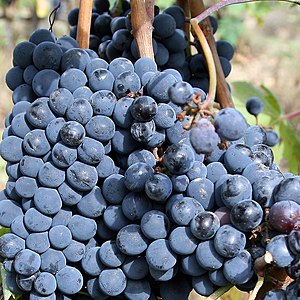 A close-up view of sangiovese grapes to be made into Chianti at the Colle Lungo vineyard in Castellina in Chianti, Tuscany, Italy (Photo credit: Wikipedia)
A close-up view of sangiovese grapes to be made into Chianti at the Colle Lungo vineyard in Castellina in Chianti, Tuscany, Italy (Photo credit: Wikipedia)By Giovanni Balboni
While there are many people who might enjoy a wonderful holiday with a Chianti villa rental, there is one subsection of the general populace who find it particularly appealing - ampelographers! Confused? Don't worry - if you've never heard it before, ampelography is just the term for the field of botany which studies the classification and identification of grapevines. As a scientific discipline, it grew to prominence in the 19th century, as it became important to gain a greater knowledge of grapevines in the face of diseases and pests such as phylloxera. The grape vine is an extremely mutable species, making the study of it absolutely fascinating - and its good news for wine lovers as well, as it allows the range of different vintages we enjoy today. An ampelographer visiting Chianti will find a lot to mull over while sampling the region's wines.
Beginnings
The earliest known documents pertaining to a Chianti wine were discovered from the 13th century, when the practice of viticulture was known to be flourishing in the mountains around Florence. Records made in 1398 note that the first recorded vintage was a white wine - meaning those sampling a glass or two in their Chianti villa rental are engaging in a long tradition. It wasn't until 1716, however, that the Grand Duke of Tuscany issued an edict that the three villages of the 'Lega del Chianti' would be the only officially recognized producers of the wine - an edict which lasted up until the 1930's when the Italian government broadened the scope of the area.
Chianti Ampelography
By the 18th century, Chianti was widely recognised as a red wine - and it may be much more familiar to those staying in a Chianti villa rental in this form! However, there's plenty available for the dedicated ampelographer to discover in the writings of Cosimo Villifranchi, an Italian writer who practised his trade in the same time period. It was through his writings that avid scholars could discover the types of grape that were planted in the region - Mammolo, Marzemino, and Canaiolo.
Of these, Canaiolo was likely the most dominant grape used in the region's wines, and would likely have been the one most associated with the local vintages of the time. Part of this success may be attributable to the 'governo' winemaking techniques of the time, which often had their best results with Canaiolo grapes. Those exploring the countryside from their Chianti villa rental will be able to see many vineyards descended from the regions ancient Canaiolo plants.
Giovanni Balboni works for To Tuscany, who specialise in finding the perfect Chianti villa rental as well as selected villas in Umbria and Puglia. To Tuscany is proud of their villas and their reputation. Each Chianti villa rental is personally selected and visited by our representatives to ensure we offer only the best in the region.
Article Source: http://EzineArticles.com/?expert=Giovanni_Balboni
http://EzineArticles.com/?The-Ampelography-of-Chianti&id=6970301
E-Book
Print Book
